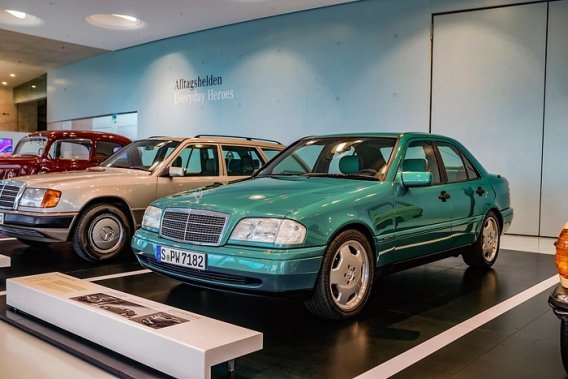Individuality with designo: The C 280 “Sport” in the Mercedes-Benz Museum
- 11 Pictures
- 2 Documents
- C-Class six-cylinder saloon with designo green metallic paintwork
- The C 280 is the top model of the 202 series in its debut year 1993
- Mercedes-Benz has offered a wide variety of factory paint finishes since the 1950s
“Close-up” – the name of this series from the Mercedes-Benz Museum says it all. Each instalment tells a surprising, exciting or behind-the-scenes story, illuminating details of a vehicle, an exhibit or an architectural or design feature. In the spotlight this time: the Mercedes-Benz C 280 from 1996 in Collection Room 5: Gallery of Everyday Heroes.
No. 1/2025: Mercedes-Benz C 280 (W 202)
A bold statement: This Mercedes-Benz C 280 from the 202 model series certainly attracts attention. All the body surfaces, front and rear aprons, trim strips and exterior mirrors of the sporty saloon are painted in intense designo green metallic, which has the Mercedes-Benz colour code 252. The C-Class with its 2.8-litre six-cylinder engine radiates springtime verve and energy all year round. Museum visitors can see this for themselves in Collection Room 5.
Top model: The first generation of the C-Class made its debut in May 1993. At that time the C 280 was the top model in the 202 model series. Its six-cylinder in-line engine delivered 142 kW (193 hp), with an automatic transmission transferring the power to the road. The C 36 AMG became top model of the series in September 1993.
Sporty highlights: The dynamic appearance of the C 280 on display is emphasised by the “Sport” design and equipment line. This includes, for example, a suspension lowered by 25 millimetres, a firmer suspension set-up and wide-base tyres as standard, as well as light-alloy wheels in AMG design on the vehicle on display. From 1993, Mercedes-Benz offered three equipment lines in the compact class in addition to the classic equipment (later “Classic”): “Esprit”, “Elegance” and “Sport”.
Modern saddlery: The theme colour green is continued in the designo interior. Both the seats and the door panelling play with the contrast between central green elements and black sides. With this customised design, Mercedes-Benz demonstrates the saddler’s art with a flair for sporty aesthetics. Using the rear seat unit as an example, the various rectangular, green components of the seat, backrest and head restraint together form a vertical stripe – as if dynamically applied with a brush on the canvas of a modern work of art.
Individual appeal: The designo paintwork of the C 280 dating from 1996 and displayed in the Mercedes-Benz Museum is a testament to its time. One year earlier, in 1995, the first Mercedes-Benz designo consulting centre opened in the customer centre at the Sindelfingen plant. Mercedes-Benz experts were on hand to discuss and plan their individual dream cars with customers. Nowadays the MANUFAKTUR individualisation range across all model series offers exclusive equipment for the exterior and interior – including MANUFAKTUR paint finishes. In December 2024, Mercedes-Benz opened the new MANUFAKTUR Studio in the heart of the Sindelfingen plant. Here, customers can experience first-hand how their vehicle is customised according to their personal wishes with attention to detail, classic craftsmanship and state-of-the-art production technologies.
Explosion of colours: Colourful paint finishes for the high-quality individualisation of cars play an important part in the history of the brand. In the second half of the 1950s, Mercedes-Benz significantly expanded the colour range: in 1953, passenger cars bearing the star were only available in five different paint finishes as standard. By 1956, there was already an opulent colour range with 26 monotone and 23 two-tone paint finishes.
Great variety: During the model offensive of the 1990s, Mercedes-Benz once again focused on prominent colours for individual appeal. Examples among recent classics include the SLK (R 170, from 1996) in intense yellow or the CLK Coupé (C 208, from 1997) in bright blue metallic.
Special EnChroma® goggles: At the Mercedes-Benz Museum, visitors with colour vision deficiency are also able to enjoy the full beauty of colourful paint finishes like that of the C 280. Because for more than a year, the Museum has made it possible to borrow special EnChroma® goggles free of charge for the duration of a visit. These goggles filter a small part of the colour spectrum from the visible light, making it possible to see clear, vivid colours despite colour vision deficiency.
Pictures
11











Documents
2
- 4 Pages
- 149.9 KB
- 4 Pages
- 146.6 KB
